Responses of Acidobacteria Granulicella sp. WH15 to High Carbon Revealed by Integrated Omics Analyses
Abstract
1. Introduction
2. Materials and Methods
2.1. Genome
2.2. Growth Experiments
2.3. Transcriptome
2.4. Analysis of the Cytosolic Proteome by Mass Spectrometry and Data Analysis
2.5. Data Availability
3. Results
3.1. Genome Annotation and CAZymes
3.2. Transcriptome Analysis
3.3. Proteome Analysis
3.4. Upregulated Proteins
3.5. Downregulated Proteins
4. Discussion
Supplementary Materials
Author Contributions
Funding
Acknowledgments
Conflicts of Interest
References
- Kielak, A.M.; Barreto, C.C.; Kowalchuk, G.A.; van Veen, J.A.; Kuramae, E.E. The ecology of acidobacteria: Moving beyond genes and genomes. Front. Microbiol. 2016, 7, 16. [Google Scholar] [CrossRef] [PubMed]
- Kishimoto, N.; Kosako, Y.; Tano, T. Acidobacterium capsulatum gen. nov., sp. nov.: An acidophilic chemoorganotrophic bacterium containing menaquinone from acidic mineral environment. Curr. Microbiol. 1991, 22, 1–7. [Google Scholar] [CrossRef]
- Kielak, A.M.; Scheublin, T.R.; Mendes, L.W.; van Veen, J.A.; Kuramae, E.E. Bacterial community succession in pine-wood decomposition. Front. Microbiol. 2016, 7, 231. [Google Scholar] [CrossRef] [PubMed]
- Kuramae, E.E.; Yergeau, E.; Wong, L.C.; Pijl, A.S.; Veen, J.A.; Kowalchuk, G.A. Soil characteristics more strongly influence soil bacterial communities than land-use type. FEMS Microbiol. Ecol. 2012, 79, 12–24. [Google Scholar] [CrossRef]
- Navarrete, A.A.; Kuramae, E.E.; de Hollander, M.; Pijl, A.S.; van Veen, J.A.; Tsai, S.M. Acidobacterial community responses to agricultural management of soybean in Amazon forest soils. FEMS Microbiol. Ecol. 2013, 83, 607–621. [Google Scholar] [CrossRef]
- Pan, Y.; Cassman, N.; de Hollander, M.; Mendes, L.W.; Korevaar, H.; Geerts, R.; van Veen, J.A.; Kuramae, E.E. Impact of long-term N, P, K, and NPK fertilization on the composition and potential functions of the bacterial community in grassland soil. FEMS Microbiol. Ecol. 2014, 90, 195–205. [Google Scholar] [CrossRef]
- Hausmann, B.; Pelikan, C.; Herbold, C.W.; Köstlbacher, S.; Albertsen, M.; Eichorst, S.A.; Glavina del Rio, T.; Huemer, M.; Nielsen, P.H.; Rattei, T.; et al. Peatland Acidobacteria with a dissimilatory sulfur metabolism. ISME J. 2018, 12, 1729–1742. [Google Scholar] [CrossRef]
- Wingender, J.; Jaeger, K.-E.; Flemming, H.-C. Interaction between extracellular polysaccharides and enzymes. In Microbial Extracellular Polymeric Substances; Springer: Berlin, Germany, 1999; pp. 231–251. [Google Scholar]
- Pankratov, T.A.; Dedysh, S.N. Granulicella paludicola gen. nov., sp nov., Granulicella pectinivorans sp nov., Granulicella aggregans sp nov and Granulicella rosea sp nov., acidophilic, polymer-degrading acidobacteria from Sphagnum peat bogs. Int. J. Syst. Evol. Microbiol. 2010, 60, 2951–2959. [Google Scholar] [CrossRef]
- Whang, K.S.; Lee, J.C.; Lee, H.R.; Han, S.I.; Chung, S.H. Terriglobus tenax sp. nov., an exopolysaccharide-producing acidobacterium isolated from rhizosphere soil of a medicinal plant. Int. J. Syst. Evol. Microbiol. 2014, 64, 431–437. [Google Scholar] [CrossRef]
- Roller, B.R.K.; Stoddard, S.F.; Schmidt, T.M. Exploiting rRNA operon copy number to investigate bacterial reproductive strategies. Nat. Microbiol. 2016, 1, 1–7. [Google Scholar] [CrossRef]
- Fierer, N.; Morse, J.L.; Berthrong, S.T.; Bernhardt, E.S.; Jackson, R.B. Environmental controls on the landscape-scale biogeography of stream bacterial communities. Ecology 2007, 88, 2162–2173. [Google Scholar] [CrossRef] [PubMed]
- Foesel, B.U.; Nägele, V.; Naether, A.; Wüst, P.K.; Weinert, J.; Bonkowski, M.; Lohaus, G.; Polle, A.; Alt, F.; Oelmann, Y.; et al. Determinants of Acidobacteria activity inferred from the relative abundances of 16S rRNA transcripts in German grassland and forest soils. Environ. Microbiol. 2014, 16, 658–675. [Google Scholar] [CrossRef] [PubMed]
- Ho, A.; Lonardo, D.P.D.; Bodelier, P.L.E. Revisiting life strategy concepts in environmental microbial ecology. FEMS Microbiol. Ecol. 2017. [Google Scholar] [CrossRef] [PubMed]
- Campanharo, J.C.; Kielak, A.M.; Castellane, T.C.L.; Kuramae, E.E.; Lemos, E.G.d.M. Optimized medium culture for Acidobacteria subdivision 1 strains. FEMS Microbiol. Lett. 2016, 363, fnw245. [Google Scholar] [CrossRef] [PubMed]
- de Castro, V.H.L.; Schroeder, L.F.; Quirino, B.F.; Kruger, R.H.; Barreto, C.C. Acidobacteria from oligotrophic soil from the Cerrado can grow in a wide range of carbon source concentrations. Can. J. Microbiol. 2013, 59, 746–753. [Google Scholar] [CrossRef]
- Ward, N.L.; Challacombe, J.F.; Janssen, P.H.; Henrissat, B.; Coutinho, P.M.; Wu, M.; Xie, G.; Haft, D.H.; Sait, M.; Badger, J.; et al. Three genomes from the phylum Acidobacteria provide insight into the lifestyles of these microorganisms in soils. Appl. Environ. Microbiol. 2009, 75, 2046–2056. [Google Scholar] [CrossRef]
- Valášková, V.; de Boer, W.; Klein Gunnewiek, P.J.A.; Pospíšek, M.; Baldrian, P. Phylogenetic composition and properties of bacteria coexisting with the fungus Hypholoma fasciculare in decaying wood. ISME J. 2009, 3, 1218–1221. [Google Scholar] [CrossRef]
- Chin, C.-S.; Alexander, D.H.; Marks, P.; Klammer, A.A.; Drake, J.; Heiner, C.; Clum, A.; Copeland, A.; Huddleston, J.; Eichler, E.E.; et al. Nonhybrid, finished microbial genome assemblies from long-read SMRT sequencing data. Nat. Methods 2013, 10, 563–569. [Google Scholar] [CrossRef]
- Walker, B.J.; Abeel, T.; Shea, T.; Priest, M.; Abouelliel, A.; Sakthikumar, S.; Cuomo, C.A.; Zeng, Q.; Wortman, J.; Young, S.K.; et al. Pilon: An integrated tool for comprehensive microbial variant detection and genome assembly improvement. PLoS ONE 2014, 9, e112963. [Google Scholar] [CrossRef]
- Seemann, T. Prokka: Rapid prokaryotic genome annotation. Bioinformatics 2014, 30, 2068–2069. [Google Scholar] [CrossRef]
- Aziz, R.K.; Bartels, D.; Best, A.A.; DeJongh, M.; Disz, T.; Edwards, R.A.; Formsma, K.; Gerdes, S.; Glass, E.M.; Kubal, M.; et al. The RAST Server: Rapid Annotations using subsystems technology. BMC Genom. 2008, 9, 75. [Google Scholar] [CrossRef] [PubMed]
- Galperin, M.Y.; Makarova, K.S.; Wolf, Y.I.; Koonin, E.V. Expanded microbial genome coverage and improved protein family annotation in the COG database. Nucleic Acids Res. 2015, 43, D261–D269. [Google Scholar] [CrossRef] [PubMed]
- Kanehisa, M. KEGG: Kyoto encyclopedia of genes and genomes. Nucleic Acids Res. 2000, 28, 27–30. [Google Scholar] [CrossRef] [PubMed]
- Zhang, H.; Yohe, T.; Huang, L.; Entwistle, S.; Wu, P.; Yang, Z.; Busk, P.K.; Xu, Y.; Yin, Y. dbCAN2: A meta server for automated carbohydrate-active enzyme annotation. Nucleic Acids Res 2018, 46, W95–W101. [Google Scholar] [CrossRef]
- Lombard, V.; Golaconda Ramulu, H.; Drula, E.; Coutinho, P.M.; Henrissat, B. The carbohydrate-active enzymes database (CAZy) in 2013. Nucleic Acids Res 2014, 42, D490–D495. [Google Scholar] [CrossRef]
- Stothard, P.; Wishart, D.S. Circular genome visualization and exploration using CGView. Bioinformatics 2004, 21, 537–539. [Google Scholar] [CrossRef]
- Yoon, S.-H.; Ha, S.-m.; Lim, J.; Kwon, S.; Chun, J. A large-scale evaluation of algorithms to calculate average nucleotide identity. Antonie Van Leeuwenhoek 2017, 110, 1281–1286. [Google Scholar] [CrossRef]
- Langmead, B.; Salzberg, S.L. Fast gapped-read alignment with Bowtie 2. Nat. Methods 2012, 9, 357–359. [Google Scholar] [CrossRef]
- Li, B.; Dewey, C.N. RSEM: Accurate transcript quantification from RNA-Seq data with or without a reference genome. BMC Bioinform. 2011, 12, 323. [Google Scholar] [CrossRef]
- Robinson, M.D.; McCarthy, D.J.; Smyth, G.K. edgeR: A Bioconductor package for differential expression analysis of digital gene expression data. Bioinformatics 2009, 26, 139–140. [Google Scholar] [CrossRef]
- Grube, M.; Cernava, T.; Soh, J.; Fuchs, S.; Aschenbrenner, I.; Lassek, C.; Wegner, U.; Becher, D.; Riedel, K.; Sensen, C.W.; et al. Exploring functional contexts of symbiotic sustain within lichen-associated bacteria by comparative omics. ISME J. 2014, 9, 412–424. [Google Scholar] [CrossRef] [PubMed]
- Stopnisek, N.; Zühlke, D.; Carlier, A.; Barberán, A.; Fierer, N.; Becher, D.; Riedel, K.; Eberl, L.; Weisskopf, L. Molecular mechanisms underlying the close association between soil Burkholderia and fungi. ISME J. 2016, 10, 253–264. [Google Scholar] [CrossRef] [PubMed]
- Zhang, Y.; Wen, Z.; Washburn, M.P.; Florens, L. Refinements to label free proteome quantitation: How to deal with peptides shared by multiple proteins. Anal. Chem. 2010, 82, 2272–2281. [Google Scholar] [CrossRef] [PubMed]
- Saeed, A.I.; Sharov, V.; White, J.; Li, J.; Liang, W.; Bhagabati, N.; Braisted, J.; Klapa, M.; Currier, T.; Thiagarajan, M.; et al. TM4: A free, open-source system for microarray data management and analysis. Biotechniques 2003, 34, 374–378. [Google Scholar] [CrossRef] [PubMed]
- Schneider, T.; Schmid, E.; de Castro, J.V.; Cardinale, M.; Eberl, L.; Grube, M.; Berg, G.; Riedel, K. Structure and function of the symbiosis partners of the lung lichen (Lobaria pulmonaria L. Hoffm.) analyzed by metaproteomics. Proteomics 2011, 11, 2752–2756. [Google Scholar] [CrossRef] [PubMed]
- Perez-Riverol, Y.; Csordas, A.; Bai, J.; Bernal-Llinares, M.; Hewapathirana, S.; Kundu, D.J.; Inuganti, A.; Griss, J.; Mayer, G.; Eisenacher, M.; et al. The PRIDE database and related tools and resources in 2019: Improving support for quantification data. Nucleic Acids Res. 2019, 47, D442–D450. [Google Scholar] [CrossRef]
- Eichorst, S.A.; Trojan, D.; Roux, S.; Herbold, C.; Rattei, T.; Woebken, D. Genomic insights into the Acidobacteria reveal strategies for their success in terrestrial environments. Environ. Microbiol. 2018, 20, 1041–1063. [Google Scholar] [CrossRef]
- Mannisto, M.K.; Rawat, S.; Starovoytov, V.; Haggblom, M.M. Granulicella arctica sp. nov., Granulicella mallensis sp. nov., Granulicella tundricola sp. nov. and Granulicella sapmiensis sp. nov., novel acidobacteria from tundra soil. Int. J. Syst. Evol. Microbiol. 2012, 62, 2097–2106. [Google Scholar] [CrossRef]
- Rawat, S.R.; Männistö, M.K.; Starovoytov, V.; Goodwin, L.; Nolan, M.; Hauser, L.; Land, M.; Davenport, K.W.; Woyke, T.; Häggblom, M.M. Complete genome sequence of Granulicella tundricola type strain MP5ACTX9T, an Acidobacteria from tundra soil. Stand Genom. Sci. 2013, 9, 449–461. [Google Scholar] [CrossRef]
- Rawat, S.R.; Männistö, M.K.; Starovoytov, V.; Goodwin, L.; Nolan, M.; Hauser, L.J.; Land, M.; Davenport, K.W.; Woyke, T.; Häggblom, M.M. Complete genome sequence of Granulicella mallensis type strain MP5ACTX8T, an acidobacterium from tundra soil. Stand Genom. Sci. 2013, 9, 71–82. [Google Scholar] [CrossRef]
- Kielak, A.M.; Castellane, T.C.L.; Campanharo, J.C.; Colnago, L.A.; Costa, O.Y.A.; Corradi da Silva, M.L.; van Veen, J.A.; Lemos, E.G.M.; Kuramae, E.E. Characterization of novel Acidobacteria exopolysaccharides with potential industrial and ecological applications. Sci. Rep. 2017, 7, 41193. [Google Scholar] [CrossRef] [PubMed]
- Zweers, J.C.; Nicolas, P.; Wiegert, T.; van Dijl, J.M.; Denham, E.L. Definition of the σW regulon of Bacillus subtilis in the absence of stress. PLoS ONE 2012, 7, e48471. [Google Scholar] [CrossRef] [PubMed][Green Version]
- Sacheti, P.; Patil, R.; Dube, A.; Bhonsle, H.; Thombre, D.; Marathe, S.; Vidhate, R.; Wagh, P.; Kulkarni, M.; Rapole, S.; et al. Proteomics of arsenic stress in the gram-positive organism Exiguobacterium sp. PS NCIM 5463. Appl. Microbiol. Biotechnol. 2014, 98, 6761–6773. [Google Scholar] [CrossRef] [PubMed]
- Christensen-Dalsgaard, M.; Jørgensen, M.G.; Gerdes, K. Three new RelE-homologous mRNA interferases of Escherichia coli differentially induced by environmental stresses. Mol. Microbiol. 2010, 75, 333–348. [Google Scholar] [CrossRef] [PubMed]
- Tachdjian, S.; Kelly, R.M. Dynamic metabolic adjustments and genome plasticity are implicated in the heat shock response of the extremely thermoacidophilic archaeon Sulfolobus solfataricus. J. Bacteriol. 2006, 188, 4553–4559. [Google Scholar] [CrossRef] [PubMed]
- Jorgensen, M.G.; Pandey, D.P.; Jaskolska, M.; Gerdes, K. HicA of Escherichia coli defines a novel family of translation-independent mRNA interferases in Bacteria and Archaea. J. Bacteriol. 2008, 191, 1191–1199. [Google Scholar] [CrossRef] [PubMed]
- Gvakharia, B.O.; Permina, E.A.; Gelfand, M.S.; Bottomley, P.J.; Sayavedra-Soto, L.A.; Arp, D.J. Global Transcriptional Response of Nitrosomonas europaea to Chloroform and Chloromethane. Appl. Environ. Microbiol. 2007, 73, 3440–3445. [Google Scholar] [CrossRef]
- Hayes, C.S.; Low, D.A. Signals of growth regulation in bacteria. Curr. Opin. Microbiol. 2009, 12, 667–673. [Google Scholar] [CrossRef]
- Christensen, S.K.; Mikkelsen, M.; Pedersen, K.; Gerdes, K. RelE, a global inhibitor of translation, is activated during nutritional stress. Proc. Natl. Acad. Sci. USA 2001, 98, 14328–14333. [Google Scholar] [CrossRef]
- Nidetzky, B.; Fürlinger, M.; Gollhofer, D.; Scopes, R.K.; Haltrich, D.; Kulbe, K.D. Improved operational stability of cell-free glucose-fructose oxidoreductase from Zymomonas mobilis for the efficient synthesis of sorbitol and gluconic acid in a continuous ultrafiltration membrane reactor. Biotechnol. Bioeng. 1997, 53, 623–629. [Google Scholar] [CrossRef]
- Patel, K.; Golemi-Kotra, D. Signaling mechanism by the Staphylococcus aureus two-component system LytSR: Role of acetyl phosphate in bypassing the cell membrane electrical potential sensor LytS. F1000Research 2015, 4, 79. [Google Scholar] [CrossRef] [PubMed]
- Li, Y.; Zhou, H. tRNAs as regulators in gene expression. Sci. China C Life Sci. 2009, 52, 245–252. [Google Scholar] [CrossRef] [PubMed]
- Murray, L.E.; Rowley, N.; Dawes, I.W.; Johnston, G.C.; Singer, R.A. A yeast glutamine tRNA signals nitrogen status for regulation of dimorphic growth and sporulation. Proc. Natl. Acad. Sci. USA 1998, 95, 8619–8624. [Google Scholar] [CrossRef]
- Torrent, M.; Chalancon, G.; de Groot, N.S.; Wuster, A.; Madan Babu, M. Cells alter their tRNA abundance to selectively regulate protein synthesis during stress conditions. Sci. Signal. 2018, 11, eaat6409. [Google Scholar] [CrossRef]
- Rosner, J.L.; Martin, R.G. An Excretory function for the Escherichia coli outer membrane pore TolC: Upregulation of marA and soxS transcription and rob activity due to metabolites accumulated in tolC mutants. J. Bacteriol. 2009, 191, 5283–5292. [Google Scholar] [CrossRef]
- Zgurskaya, H.I.; Krishnamoorthy, G.; Ntreh, A.; Lu, S. Mechanism and function of the outer membrane channel tolc in multidrug resistance and physiology of enterobacteria. Front. Microbiol. 2011, 2. [Google Scholar] [CrossRef]
- Kim, H.S.; Nagore, D.; Nikaido, H. Multidrug Efflux Pump MdtBC of Escherichia coli Is active only as a B2C heterotrimer. J. Bacteriol. 2009, 192, 1377–1386. [Google Scholar] [CrossRef]
- Nikaido, H. Multidrug efflux pumps of gram-negative bacteria. J. Bacteriol. 1996, 178, 5853–5859. [Google Scholar] [CrossRef]
- Federici, L.; Du, D.; Walas, F.; Matsumura, H.; Fernandez-Recio, J.; McKeegan, K.S.; Borges-Walmsley, M.I.; Luisi, B.F.; Walmsley, A.R. The crystal structure of the outer membrane protein VceC from the bacterial Pathogenvibrio choleraeat 1.8 Å resolution. J. Biol. Chem. 2005, 280, 15307–15314. [Google Scholar] [CrossRef]
- Sakurai, K.; Arai, H.; Ishii, M.; Igarashi, Y. Transcriptome response to different carbon sources in Acetobacter aceti. Microbiology 2010, 157, 899–910. [Google Scholar] [CrossRef]
- Ruhal, R.; Kataria, R.; Choudhury, B. Trends in bacterial trehalose metabolism and significant nodes of metabolic pathway in the direction of trehalose accumulation. Microb. Biotechnol. 2013, 6, 493–502. [Google Scholar] [CrossRef] [PubMed]
- Chang, Y.-C.; Hu, Z.; Rachlin, J.; Anton, B.P.; Kasif, S.; Roberts, R.J.; Steffen, M. COMBREX-DB: An experiment centered database of protein function: Knowledge, predictions and knowledge gaps. Nucleic Acids Res. 2016, 44, D330–D335. [Google Scholar] [CrossRef] [PubMed]
- Bianchetti, C.M.; Elsen, N.L.; Fox, B.G.; Phillips, G.N. Structure of cellobiose phosphorylase from Clostridium thermocellum in complex with phosphate. Acta Crystallogr. Sect. F Struct. Biol. Cryst. Commun. 2011, 67, 1345–1349. [Google Scholar] [CrossRef] [PubMed]
- Thoma, R.; Hennig, M.; Sterner, R.; Kirschner, K. Structure and function of mutationally generated monomers of dimeric phosphoribosylanthranilate isomerase from Thermotoga maritima. Structure 2000, 8, 265–276. [Google Scholar] [CrossRef]
- Schön, A. Ribonuclease P: The diversity of a ubiquitous RNA processing enzyme. FEMS Microbiol. Rev. 1999, 23, 391–406. [Google Scholar] [CrossRef]
- Singh, V.; Maniar, K.; Bhattacharyya, R.; Banerjee, D. A novel insight in favor of structure–function relationship for 16S rRNA. Mol. Biol. Rep. 2018, 45, 1569–1573. [Google Scholar] [CrossRef]
- Paterson, G.K.; Cone, D.B.; Northen, H.; Peters, S.E.; Maskell, D.J. Deletion of the gene encoding the glycolytic enzyme triosephosphate isomerase (Tpi) alters morphology of Salmonella enterica serovar typhimurium and decreases fitness in mice. FEMS Microbiol. Lett. 2009, 294, 45–51. [Google Scholar] [CrossRef][Green Version]
- Grainge, I.; Sherratt, D.J. Xer Site-specific recombination. J. Biol. Chem. 1999, 274, 6763–6769. [Google Scholar] [CrossRef]
- Scieglinska, D.; Krawczyk, Z. Expression, function, and regulation of the testis-enriched heat shock HSPA2 gene in rodents and humans. Cell Stress Chaperones 2014, 20, 221–235. [Google Scholar] [CrossRef]
- Negrea, A.; Bjur, E.; Puiac, S.; Ygberg, S.E.; Aslund, F.; Rhen, M. Thioredoxin 1 participates in the activity of the Salmonella enterica aerovar Typhimurium pathogenicity island 2 type III secretion system. J. Bacteriol. 2009, 191, 6918–6927. [Google Scholar] [CrossRef]
- Houssin, C.; Eynard, N.; Shechter, E.; Ghazi, A. Effect of osmotic pressure on membrane energy-linked functions in Escherichia coli. Biochim. Biophys. Acta Bioenerg. 1991, 1056, 76–84. [Google Scholar] [CrossRef]
- Dominguez-Ferreras, A.; Perez-Arnedo, R.; Becker, A.; Olivares, J.; Soto, M.J.; Sanjuan, J. Transcriptome profiling reveals the importance of plasmid pSymB for osmoadaptation of Sinorhizobium meliloti. J. Bacteriol. 2006, 188, 7617–7625. [Google Scholar] [CrossRef] [PubMed]
- Kiley, P.J.; Donohue, T.J. Global responses of bacteria to oxygen deprivation. In Bacterial Stress Responses, 2nd ed.; ASM Press: Washington, DC, USA, 2011; pp. 175–189. [Google Scholar] [CrossRef]
- Jankovic, I.; Bruckner, R. Carbon catabolite repression by the catabolite control protein CcpA in Staphylococcus xylosus. J. Mol. Microbiol. Biotechnol. 2002, 4, 309–314. [Google Scholar]
- Warner, J.B.; Lolkema, J.S. CcpA-Dependent carbon catabolite repression in bacteria. Microbiol. Mol. Biol. Rev. 2003, 67, 475–490. [Google Scholar] [CrossRef]
- Fujita, Y. Carbon catabolite control of the metabolic network in bacillus subtilis. Biosci. Biotechnol. Biochem. 2014, 73, 245–259. [Google Scholar] [CrossRef]
- Richardson, A.R.; Somerville, G.A.; Sonenshein, A.L. Regulating the Intersection of metabolism and pathogenesis in gram-positive bacteria. Microbiol. Spectr. 2015, 3, 129–165. [Google Scholar] [CrossRef]
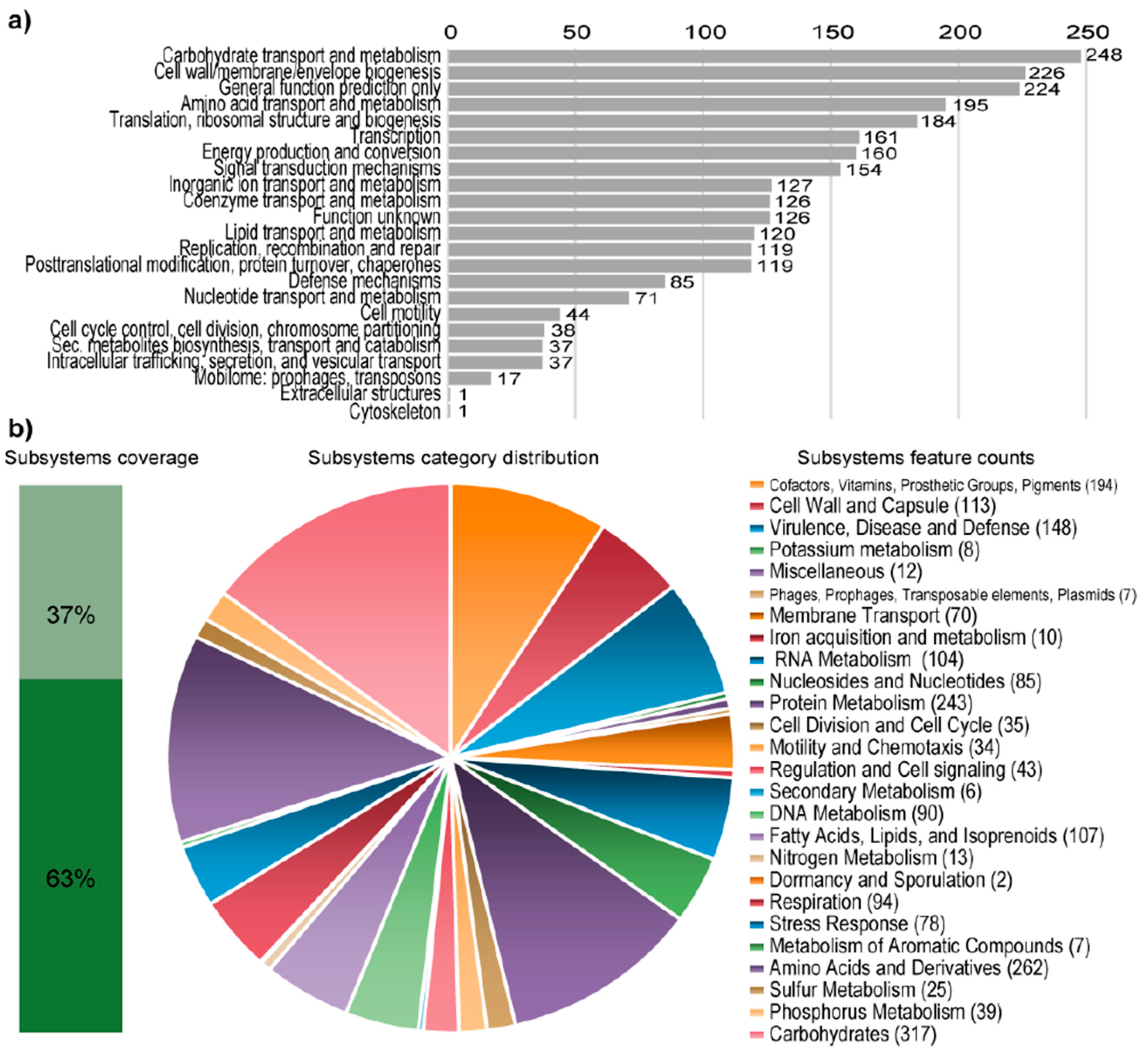
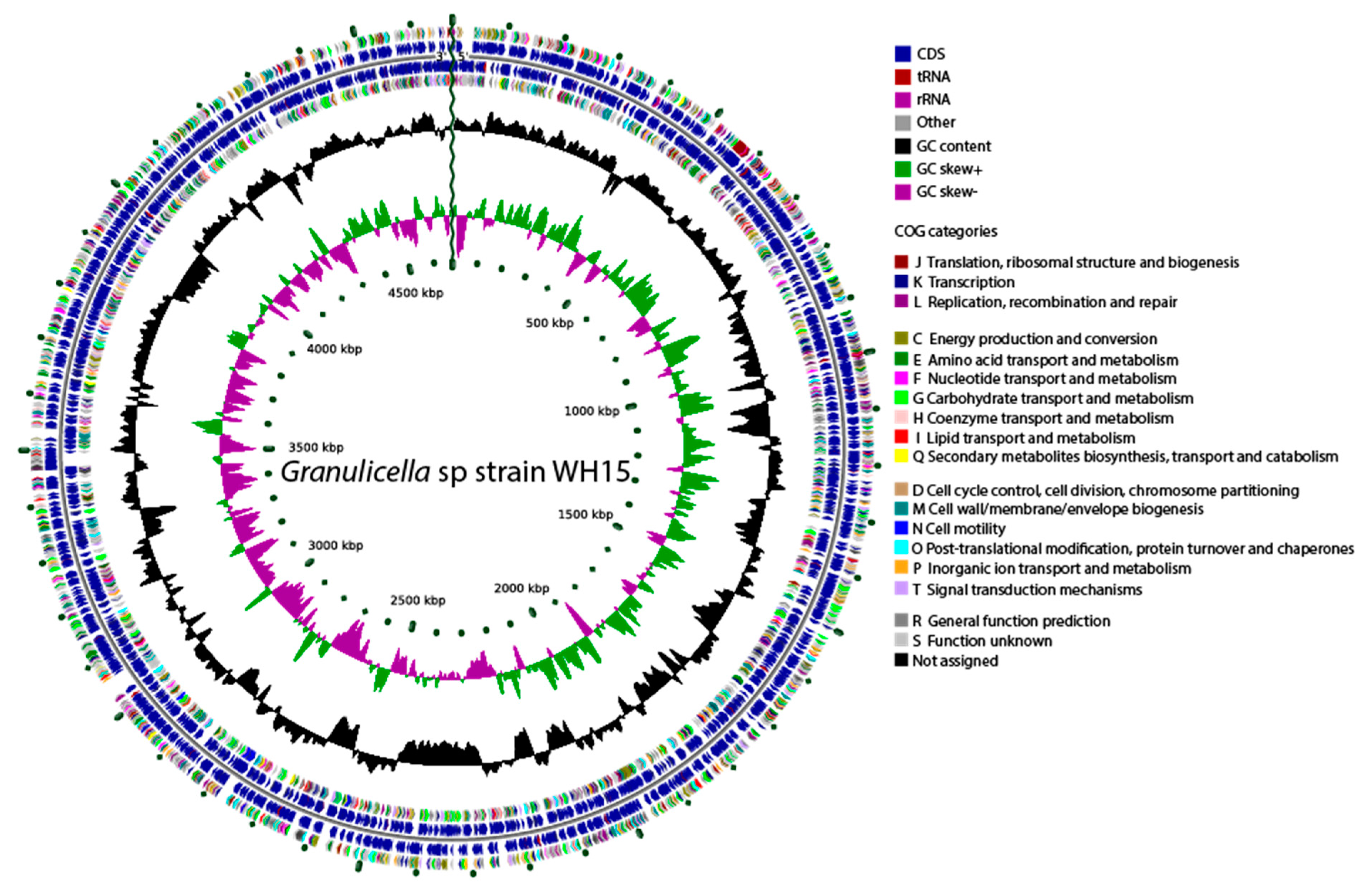
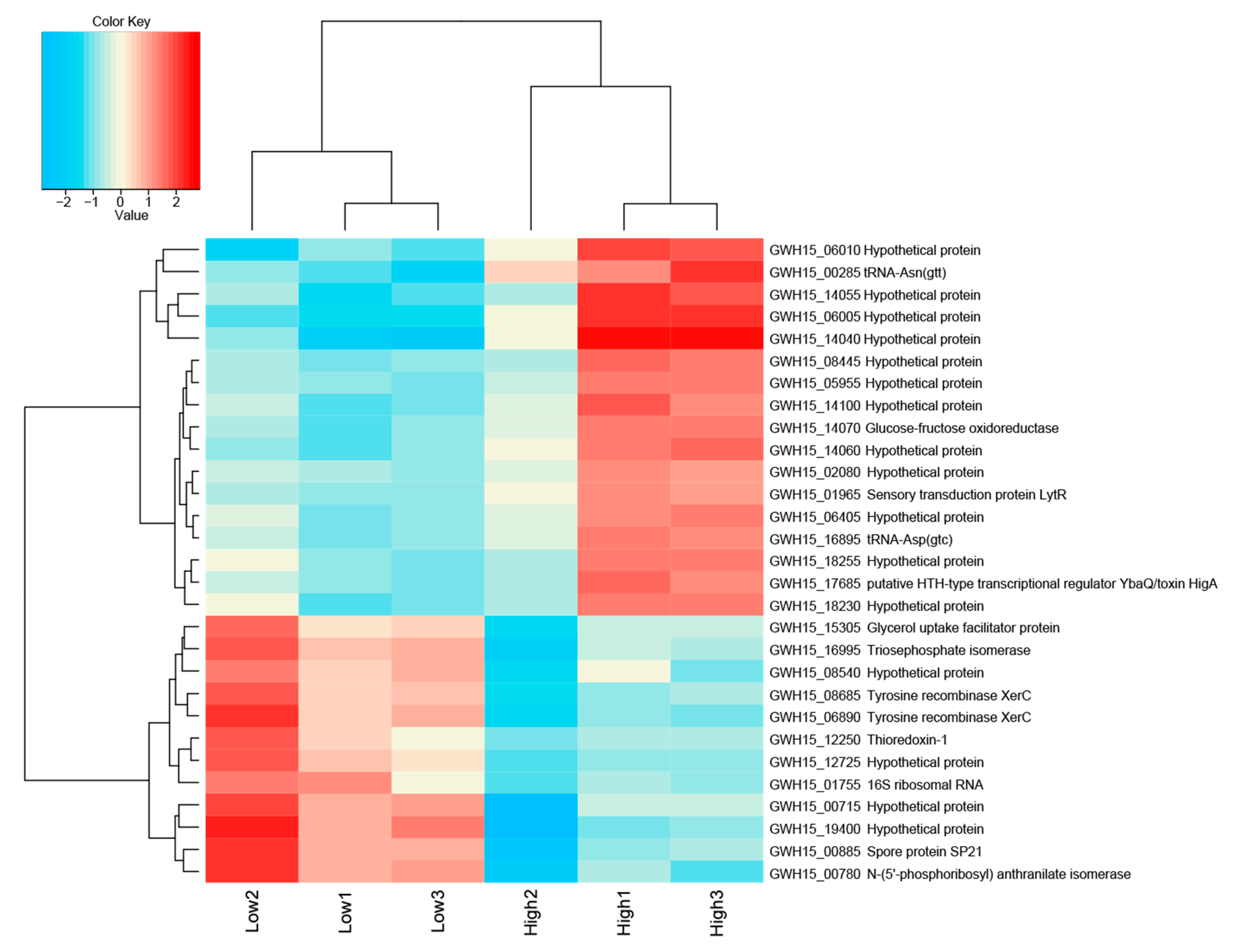
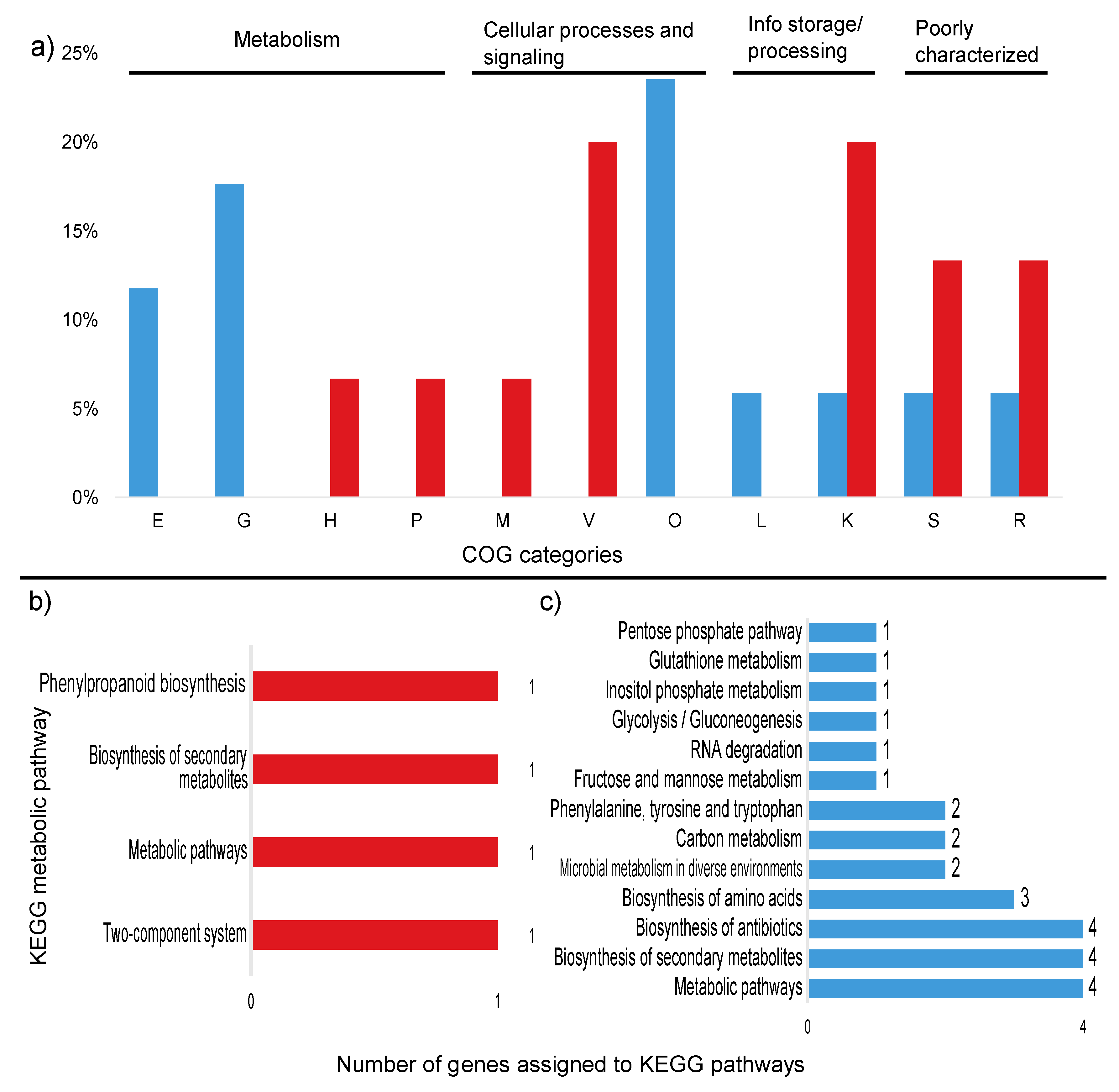
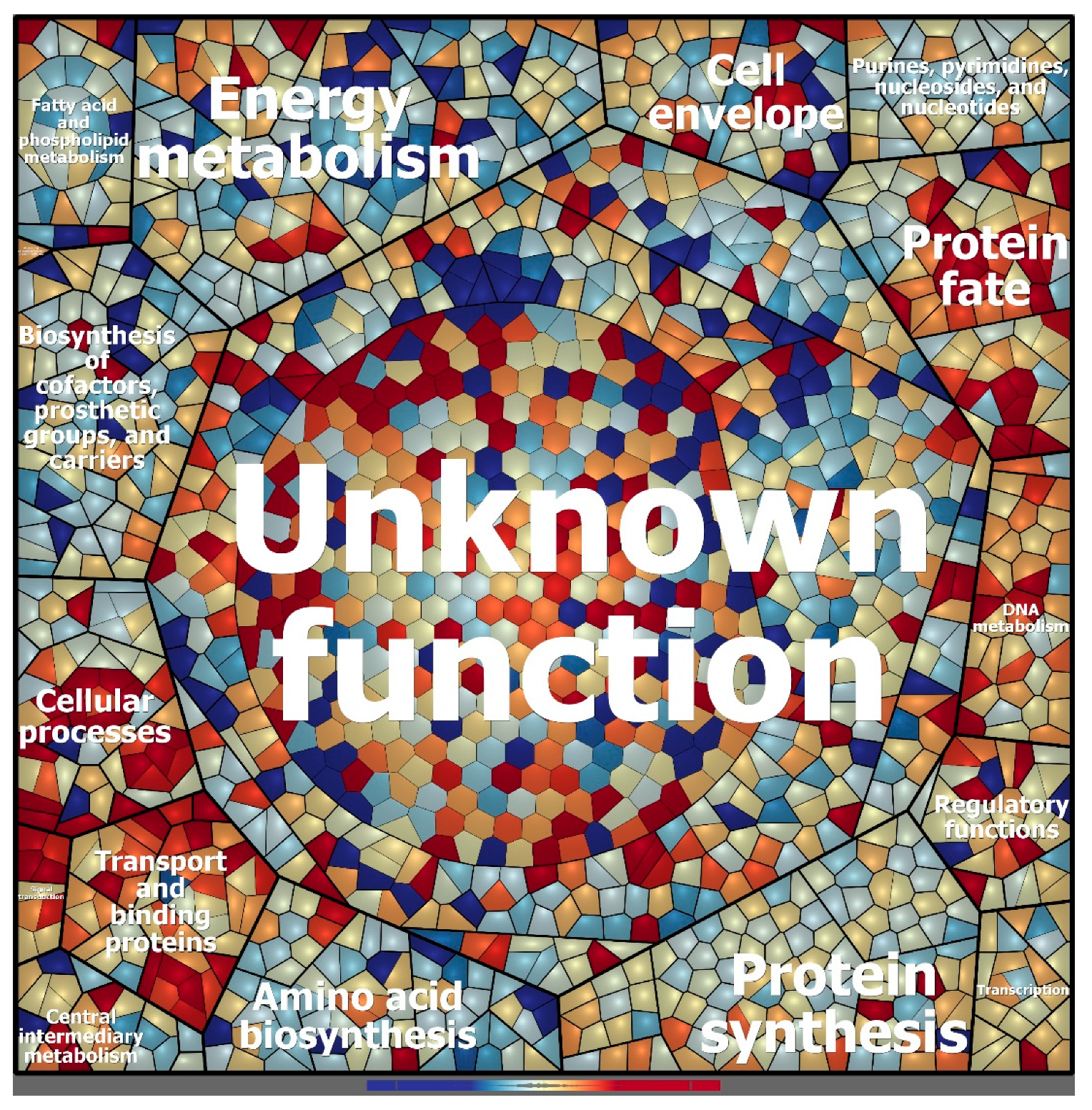
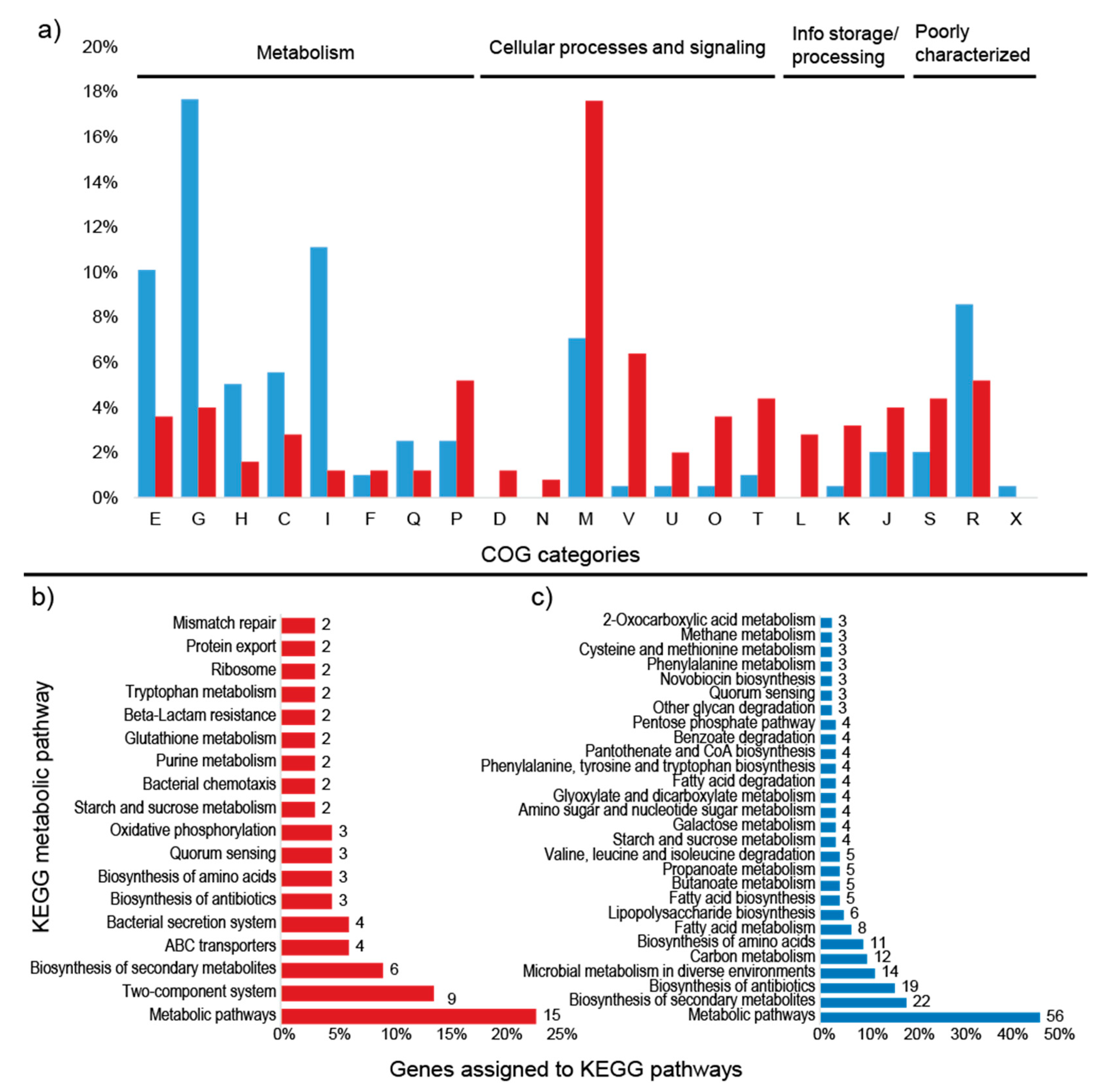
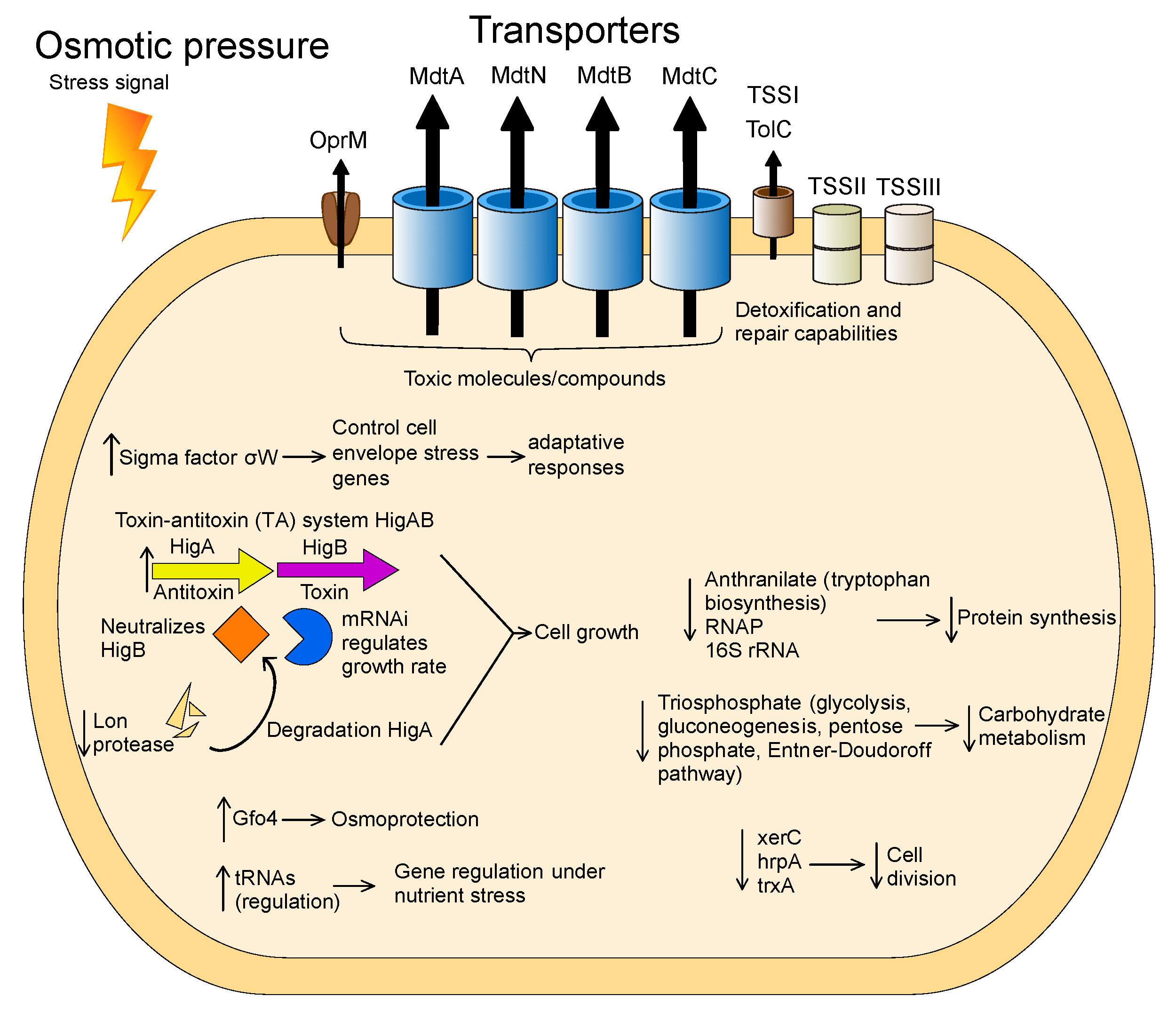
| Genome | Granulicella spp. WH15 |
|---|---|
| Size (bp) | 4,673,153 |
| G+C content (%) | 60.7 |
| Number of coding sequences | 3939 |
| Number of features in subsystems | 1456 |
| Number of RNA genes | 51 |
| Number of contigs | 1 |
| Genome | Size (bp) | G+C Content | Number of Coding Sequences | Number of Features | Number of Subsystems | Number of RNAs | ANI * |
|---|---|---|---|---|---|---|---|
| Granulicella spp. WH15 | 4,673,153 | 60.7 | 3871 | 1496 | 374 | 51 | 100 |
| Granulicella pectinivorans [9] | 4,439,413 | 61.2 | 3681 | 1066 | 302 | 41 | 73.32 |
| Granulicella mallensis MP5ACTX8 [40] | 6,237,577 | 57.9 | 5008 | 1662 | 394 | 50 | 73.03 |
| Granulicella tundricola MP5ACTX9 [41] | 5,503,984 | 60 | 4730 | 1526 | 361 | 49 | 74.12 |
| Granulicella rosea DSM 18704 [9] | 5,293,785 | 62.9 | 4515 | 864 | 250 | 55 | 75.32 |
| CAZyme Family | Counts |
|---|---|
| Auxiliary activity (AA) | 13 |
| Carbohydrate binding module (CBM) | 22 |
| Carbohydrate esterase (CE) | 41 |
| Cohesin | 1 |
| Glycoside hydrolase (GH) | 86 |
| Glycosyl transferase (GT) | 52 |
| Polysaccharide lyase (PL) | 2 |
| Total | 217 |
| Cluster | Type | Most Similar Known Cluster |
|---|---|---|
| Cluster 2 | putative | O-antigen BGC (19% of genes show similarity) |
| Cluster 3 | Cf saccharide | |
| Cluster 4 | t3pks-cf fatty acid | |
| Cluster 7 | Cf saccharide | |
| Cluster 11 | lassopeptide | |
| Cluster 13 | bacteriocin | |
| Cluster 16 | Cf saccharide | |
| Cluster 17 | Cf fatty acid-terpene | Malleobactin BGC (11% of genes show similarity) |
| Cluster 19 | t3pks | |
| Cluster 22 | terpene | |
| Cluster 26 | bacteriocin | |
| Cluster 27 | Cf saccharide | |
| Cluster 28 | putative | Thuggacin BGC (15% of genes show similarity) |
| KEGG Orthology | Gene | Related KEGG Pathways |
|---|---|---|
| K01817 | trpF | Biosynthesis of antibiotics, secondary metabolites, and amino acids; metabolic pathways; phenylalanine, tyrosine, and tryptophan biosynthesis. |
| K01803 | tpiA | Biosynthesis of antibiotics, secondary metabolites, and amino acids; metabolic pathways; phenylalanine, tyrosine, and tryptophan biosynthesis; microbial metabolism in diverse environments; carbon metabolism; inositol phosphate metabolism; fructose and mannose metabolism; glycolysis/gluconeogenesis. |
| K04043 | dnaK | RNA degradation. |
| K01609 | trpC | Biosynthesis of antibiotics, secondary metabolites, and amino acids; metabolic pathways; phenylalanine, tyrosine, and tryptophan biosynthesis. |
| K00033 | gndA | Biosynthesis of antibiotics and secondary metabolites; metabolic pathways; microbial metabolism in diverse environments; carbon metabolism; phenylalanine, tyrosine, and tryptophan biosynthesis; glutathione metabolism; pentose phosphate pathway. |
© 2020 by the authors. Licensee MDPI, Basel, Switzerland. This article is an open access article distributed under the terms and conditions of the Creative Commons Attribution (CC BY) license (http://creativecommons.org/licenses/by/4.0/).
Share and Cite
Costa, O.Y.A.; Zerillo, M.M.; Zühlke, D.; Kielak, A.M.; Pijl, A.; Riedel, K.; Kuramae, E.E. Responses of Acidobacteria Granulicella sp. WH15 to High Carbon Revealed by Integrated Omics Analyses. Microorganisms 2020, 8, 244. https://doi.org/10.3390/microorganisms8020244
Costa OYA, Zerillo MM, Zühlke D, Kielak AM, Pijl A, Riedel K, Kuramae EE. Responses of Acidobacteria Granulicella sp. WH15 to High Carbon Revealed by Integrated Omics Analyses. Microorganisms. 2020; 8(2):244. https://doi.org/10.3390/microorganisms8020244
Chicago/Turabian StyleCosta, Ohana Y.A., Marcelo M. Zerillo, Daniela Zühlke, Anna M. Kielak, Agata Pijl, Katharina Riedel, and Eiko E. Kuramae. 2020. "Responses of Acidobacteria Granulicella sp. WH15 to High Carbon Revealed by Integrated Omics Analyses" Microorganisms 8, no. 2: 244. https://doi.org/10.3390/microorganisms8020244
APA StyleCosta, O. Y. A., Zerillo, M. M., Zühlke, D., Kielak, A. M., Pijl, A., Riedel, K., & Kuramae, E. E. (2020). Responses of Acidobacteria Granulicella sp. WH15 to High Carbon Revealed by Integrated Omics Analyses. Microorganisms, 8(2), 244. https://doi.org/10.3390/microorganisms8020244







